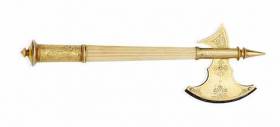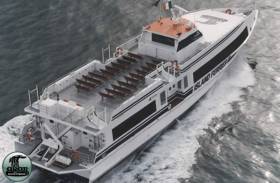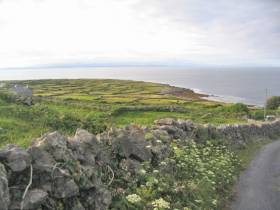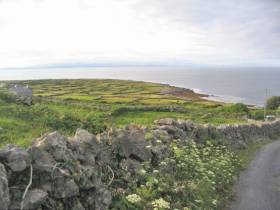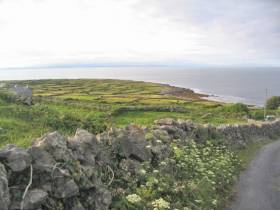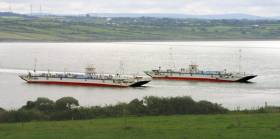Displaying items by tag: ferry
Irish Ferries Chooses ‘W. B.Yeats’ As Name For New Cruise Ferry
Irish Ferries has chosen W. B. Yeats as the name for its new €144 million cruise ferry now being built in Germany for service on routes between Ireland, UK and France. The name was chosen after it had drawn ‘strong support’ from the public in an online competition that attracted nearly 100,000 entries.
According to a spokesman: ‘it was clear from the poll that there is widespread public affection for W. B. Yeats, due in the main to the magnificence of his writings and his contribution to Irish society, theatre and the arts generally’.
Acclaimed as one of the greatest poets of the 20th century and one of Ireland’s foremost literary figures, W. B. Yeats was born in Dublin and educated in Ireland and London.
Recipient of a Nobel Prize for Literature, he helped to found Dublin’s Abbey Theatre. Amongst the poems for which he is most fondly remembered is ‘The Lake Isle of Innisfree’, a composition inspired by his many holiday visits to Sligo, where, in a churchyard beneath Ben Bulben, his remains now rest.
The decision by Irish Ferries to name their new vessel W. B. Yeats is one that continues the tradition adopted by the company of selecting names drawn from the world of Irish literature.
Commenting, its managing director, Andrew Sheen said: “In choosing W. B. Yeats from the many whose works are revered by Irish people and students of literature the world over, we have selected one that will give the new vessel its own distinct identity and stir memories of a poet who is held in high esteem by so many, here and abroad”.
In addition to the weight of public support that W. B. Yeats received, operational factors that influenced its choice included the importance of picking a name that would have a high degree of public recognition and appeal in those overseas markets into which the vessel will operate and from which Ireland draws a significant volume of its tourism and trade.
Ships’ registration, regulation and other operational and legal aspects also ranked amongst the factors that needed to be considered, as was the desire to choose a name that would sit comfortably alongside those other great literary figures whose names adorn other vessels in the Irish Ferries fleet.
Noting that W. B. Yeats is one that will need no introduction to people across the world, Andrew Sheen said: “It is a name that will convey a sense of the magnificence and grandeur that passengers can expect when travelling on our new vessel, sailings of which are expected to commence on the Dublin – Holyhead and Ireland – France routes from mid-Summer next year”.
When built, the W. B. Yeats will have space for 1,885 passengers and crew, 1,200 cars and 440 cabins including luxury suites with their own private balconies. Other facilities will include a Club Class lounge with direct passenger access from the car decks, á la carte and self-service restaurants, cinema, shopping mall, choice of bars and lounges and exclusive areas for freight drivers. Pet owners will also be comforted in knowing that dedicated facilities for pets are also being provided on board.
Noteworthy in the context is that Sandymount, where Yeats was born, is located on the city’s southern coastline from where residents can look out upon the shipping channel into Dublin port along which the vessel that will bear his name will sail.
Leitrim woman wins free travel for life after suggesting Yeats’ name
The choice of W. B. Yeats as the name for the new vessel has proven to be a lucky link for Co. Leitrim woman, Lee Maxwell from Manorhamilton. Living close to Yeats’ beloved Co. Sligo, Lee’s good fortune in being chosen from the huge number of participants who suggested the poet’s name is said by Irish Ferries to be proof of what a ‘magical’ choice the name W. B. Yeats is. Picked from the thousands who shared her choice, Lee’s prize of free travel for life will be presented to her shortly.
Irish Ferry S.S. Ulster Launching Axe To Be Auctioned in London
A 15 carat gold and ivory launching axe for the Irish ferry S.S. Ulster, is under the hammer on Wednesday at Bonham's Marine Auction in London. The ceremonial axe has a fluted ivory shaft, gold terminal inscribed "ULSTER" / launched at / BIRKENHEAD / 27th June 1896, it is 8in (20cm) long. The guide price is €700 - 930.
According to Bonhams, the passenger ship, Ulster, built by Laird Bros. in Birkenhead, was launched by the Duchess of Abercorn on 27th July, 1896. Registered at 2632 tons, Ulster replaced an earlier ship of the same name for the City of Dublin Steam Packet Co. She was withdrawn from service in 1920 and broken up in 1924.
More here
Stormy Irish Sea Forecast Prompts Ferry Cancellations
#IrishSea - “Averse conditions in the Irish Sea” have prompted the cancellation of six Irish Ferries sailings between Dublin and Holyhead tomorrow (Friday 23 December), as The Irish Times reports.
Passengers scheduled to travel from Dublin on the 8.45am and 10.45am ferries are advised to catch the 8.05am departure instead, while afternoon travellers are asked to make their trip later on the 8.05pm or 8.55pm sailing.
Those coming from Holyhead at 11.50am, meanwhile, will be accommodated on the next sailing some two hours later, though late afternoon travellers will have to wait till the early hours of Saturday morning (24 December).
The cancellations come as Storm Barbara sweeps in from the North Atlantic across the north of Scotland, bringing with it a high risk of stormy weather conditions in the coastal counties of Connacht and Ulster.
Inis Mór Ferry Operator Makes Deal To Halve Passenger Levy & Resume Winter Service
#AranIslands - The deadlock over Inis Mór’s winter ferry service appears to be over, after the ferry operator agreed to continue absorbing the costs of the council-imposed passenger levy.
According to Galway Bay FM, Island Ferries Teo’s proposal to reduce the levy both retroactively to 2012 and from 2017 onwards has been approved by Galway County Council.
The operator had halted services to the largest of the Aran Islands at the end of November, citing “negative fiscal conditions” that it said were a consequence of the 80c passenger levy.
It’s now emerged that half of the company’s €500,000 debt to the council will be written off, not counting upwards of €450,000 in court costs.
Sailings were restored within days on a temporary basis as talks between the company, Galway County Council and the Department of the Gaeltacht resumed earlier this month.
It’s now expected that winter sailings to and from the island will continue beyond the revised 4 January end date.
Body Recovered In Search For Woman Missing From Irish Sea Ferry
#Ferry - The body of a woman was recovered from the water in South Wales yesterday (Friday 2 December) after a major search operation for a person missing from a Pembroke-to-Rosslare ferry, as the Western Telegraph reports.
Irish Ferries’ Isle of Inishmore contacted the UK Coastguard from Rosslare shortly after 8am when the passenger was noted as missing and feared to have gone overboard, according to Sky News, prompting a major air and sea search of the Irish Sea and the Pembroke Channel at Milford Haven.
Dyfed Powys Police later confirmed the discovery of a body in the Lawrenny area east of Pembroke Dock in the upper reaches of the Western Cleddau, though it has not formally been identified.
Operator Pulls Inis Mór Winter Ferry Service
#AranIslands - Ferry services to the mainland from the largest of the Aran Islands will be suspended till March from tomorrow following a last-ditch effort to extend winter sailings.
As previously reported on Afloat.ie, Inis Mór residents were guaranteed their ferry till the end of today (Wednesday 30 November) pending a Galway County Council meeting this week to discuss a long-running dispute over passenger levies.
However, ferry operator Island Ferries Teo has now confirmed to Galway Bay FM that it will withdraw the island's winter service to from tomorrow (Thursday 1 December) till 17 March next year, citing “negative fiscal conditions”.
Aran Islands Ferry Service Extended By Fortnight
#AranIslands - Inis Mór residents have a guaranteed ferry service for two more weeks pending talks over the operator’s planned withdrawal from the island till spring.
Island Ferries Teo confirmed to Galway Bay FM that services from the Galway mainland to the largest of the Aran Islands would continue till Thursday 1 December, two weeks from today (Thursday 17 November).
That’s two days after Galway county councillors are scheduled to discuss the company’s ongoing dispute over passenger levies on 28 November.
As previously reported in Afloat.ie, the ferry operator intends to suspend its “commercially unsustainable” Inis Mór winter service till mid March next year unless the issue of levies is addressed.
Dealing Fairly With Islanders, A Part of Our Maritime Tradition
I have a great respect for those who live on our offshore islands…They are a huge part of our national culture, history and maritime tradition. To maintain island life they deserve support from all those who interact with them, both State and private. Once again, however, the Aran Islanders who live on Inish Mór are, effectively, being held to ransom in a battle between the State, the local authority in Galway and the ferry company which serves the island. Like my phraseology or not, that is the realistic assessment of the situation and I always approach such an analysis from the basis of not alone being balanced, but being fair.
The situation is highlighted in this new edition of THIS ISLAND NATION programme, by Rhoda Twombly, Secretary of Comhdháil Óileán na hÉireann, the Islands Federation.
She is, of course, addressing the situation from the point of view of the islanders when she says: “Inish Mór is facing into another Winter of uncertain ferry service. Island Ferries has stated that they will withdraw their service to the island from the 21st of November until the following 17th of March unless there is agreement between the company, the Government and Galway County Council (GCC) on levy charges at Cill Rónáin harbour. The uncertainty of ferry service has hovered over Inish Mór for the past four years and it really is time to bring a definite resolution to the matter.”
There are, I have learned in my journalistic career, not just two sides to every story, but several, depending upon the number of sides involved, but this dispute over levies in regard to improvements to the harbour at Kilronan and the paying of them as a contribution for better facilities or, on the other hand, the commitment which the State and also, perhaps, through its local authority, should make towards the physical resources of an offshore island, has been going on for far too long. It seems to have become a “hardy annual.”
I have a great respect for those who live on our offshore islands.
I hope the ferry problem to Inish Mór will be resolved.
• Listen to Listen to Rhoda Twombly on THIS ISLAND NATION Podcast below
Inis Mór Ferry Services Suspended Till Spring Over Levy Dispute
#AranIslands - “Policy decisions beyond our control” have been cited by Island Ferries Teo for its suspension of services between the mainland and the largest of the Aran Islands from November till next spring, as Galway Bay FM reports.
The move follows a long-running dispute over a council-imposed passenger levy for the non-PSO ferry route to Inis Mór that’s been subject to sharp fare increases over a number of years.
Earlier this year a deal was reached to extend ferry services to the island that were slated to end in January, after a Supreme Court ruling that forced the company to pay landing charges, according to TheJournal.ie.
However, the company now says it has reached an impasse with the Government and Galway County Council and had been left with no course of action other than to suspend the “commercially unsustainable” winter service.
TheJournal.ie has more on the story HERE.
Frequency On Shannon Shifts to Winter Schedule
#Schedule -Ireland’s longest river crossing by car ferry, operated by Shannon Ferries, have introduced a winter schedule timetable, writes Jehan Ashmore.
A winter sailing frequency on their 20 minute crossing of the estuary along the Wild Atlantic Way, between counties Clare and Kerry was introduced last weekend.
According to the operator, there will be single ferry operating with sailings from Killimer to Tarbert every hour on the hour from 7am to 7pm.
For crossings in the opposite direction, sailings from Tarbert to Killimer are every hour on the half hour from 7.30am to 7.30pm. Whereas, Sunday sailings commence two hours later.
The winter sailing continuous to 31st March, 2017, from thereon a revised schedule begins for April and May in advance of high-season traffic over the summer months.
Carrying a mix of vehicle types, including coaches and HGV’s, are a pair of UK built double-ended ro-ro half-sisters ferries. Shannon Dolphin (52 cars/350 pass) and the slightly larger Shannon Breeze, albeit in terms of a 60 vehicle capacity.
The ferries were purpose built by Appledore Shipbuilders, north Devon, during 1995 and 2000 respectively.
.



























